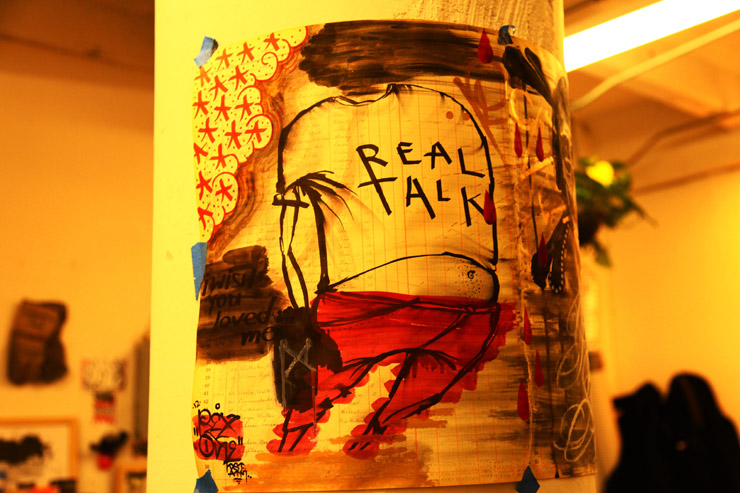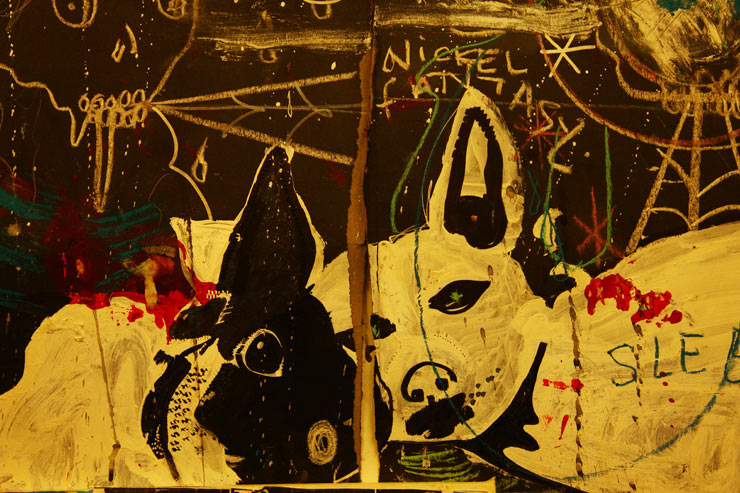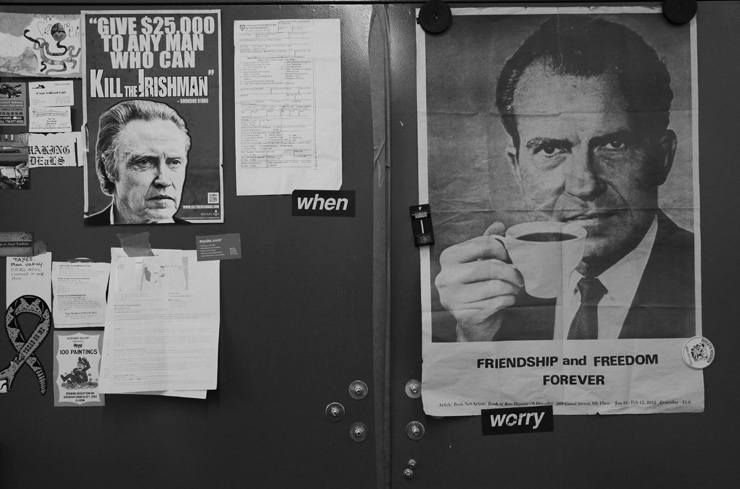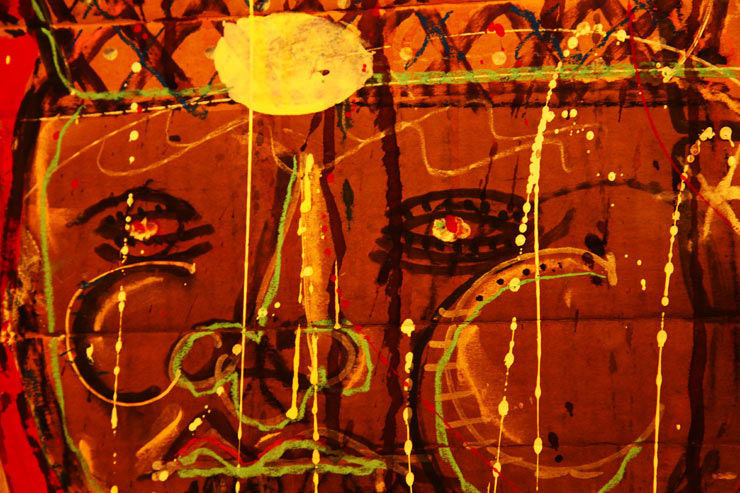Why One Brooklyn Stick Up Kid is Worth Watching
Sometimes on the street you get an inkling of the future. It could be an overheard excerpt from a cell-phone conversation about a club show the night before, or the color and texture of woman’s blouse as it flutters around her while she reads on a park bench, or the sight of the 3rd food truck this week selling spicy meatballs. Something tells you that you just got a glimpse of the future. And while it doesn’t completely reveal itself in it’s fullness, you can see a nascent potential, a storyline developing that may go far beyond it’s current self. Sometimes when you see a Kosbe sticker on a paper box, it feels that way too. In fact, each time you see one of his pieces on the street, it grabs you from above the fray. Yet it seems like he’s been under the radar. He may not stay there much longer.
Kosbe (photo © Jaime Rojo)
In the ebb and the flow of the Street Art conversation in New York, you keep seeing Kosbe’s wacky characters popping up in doorways and paper boxes. They aren’t tossed off little marker drawings done while watching TV – they’re intense petite character studies. Packed into one slapped on sticker is a lot of cacophonic kineticism; near crazed city characters with primitive wild eyes staring or blinkered, with tight jaws and teeth squarely gritted. The folk faces and forms are framed by an ardent prose, non-sequitors of angst and inside jokes. “What’s the guy saying?” you could ask. And why is he yelling? “Is he okay, is he mocking me? It’s the bundled rage and cryptic cleverness of the court jester. Layers of reapplied color and repeated lines trap multiple actions on one non-static figure. This is not simple tagging, it’s a stationary tornado.
Kosbe (photo © Jaime Rojo)
Street Artist Kosbe has put in two good decades of practice, and has learned some lessons the hard way. He’s been hitting up New York for a half decade but he comes from a long graffiti history as a kid in his native Chicago. Now a practicing artist readying a solo gallery show for fall, he grew up in a very young single-parent home where his mom created a small studio for the boy in the back of their apartment. “My mom was really supportive of me as an artist. When I was a kid she gave me this little back room that she allowed me to use like a painting studio. So I was always grabbing stuff off the street and bringing it in there, painting it. I was very secretive with my stuff. A lot of people would come over and see my stuff and they were like, ‘Dude, I didn’t know that you painted’. I was very protective of it.”
That hasn’t changed. He still likes to use found materials as canvasses, as he shows us around his small studio hidden in a warehouse in New York. “I’m always using things that I find in the streets. Like this is an old grading book from 1919,” he says as he pulls out a tattered tome with pages ripped out. “It has all these people’s signatures. I found this outside a high school in Brooklyn. It’s really cool. So that’s what I’ve been using for my drawings.”
Kosbe (photo © Jaime Rojo)
Kosbe (photo © Jaime Rojo)
Tough times at home got him in trouble at school and with the police as a youth. Describing himself as hard headed, he talks about running away as a young teen to San Francisco for a while in the early 90s, where he spent a lot of time on the street admiring a new kind of character-based and tattoo influenced graffiti on the street by people like Twist (Barry McGee), Mike Giant, and Reminisce. “I went out and there were these Reminisce horses everywhere and they were great because you were going down the street and you would see this horse like galloping down the street. This stuff really blew me away. So I think the same time this stuff was going on there, over here in NY you had like Cost and Revs posting bills and doing rollers. And back then there wasn’t the internet.”
Kosbe (photo © Jaime Rojo)
Years later here in this fluorescent lit studio filled with his drawings, paintings, books, ‘zines, assorted ephemera, a desk, and a loveseat, his excited retelling of stories reveals how much those childhood escapades running Chicago streets and exploring San Francisco formed his view of Street Art and prepared him for moving to New York eventually in the 2000s. A self-schooled student of graffiti, fine art, and street art, Kosbe can recount names of writers and crews, timelines, styles; drawing etymologies and stylistic connections and talking about migrations. With much fanfare he’ll also tell you the stories about the famed Chicago “buff” – a citywide anti graffiti campaign in the mid-late 1990s that he says whitewashed the city’s history.
Kosbe (photo © Jaime Rojo)
But now he’s an artist on his own, and his practice is daily. “Now I’ve learned more that the only way, as an artist, that you can kind of grow and come up with new ideas is you gotta keep giving them away. So that’s why street art is kind of funny. I have friends who are painters that have become painters because of me. They are like ‘Dude, I was totally influenced by your drawings’ and stuff like that.” But the practice of Street Artists putting fully formed works out on the street still confuses some of his peers, “They say ‘Dude you give all your art away’ – you know, they don’t understand the concept.”
His new work on the street and in this studio now bends toward abstract expressionism and his years of comic book reading enlivens that rawness with a furtively bombastic character-driven personality. Almost every piece he does has some sort of commentary- a sort of helpful therapeutic narrative to explain what the character is thinking or feeling at the moment. “I like being bad for the sake of being bad”, “Tupac!”, “deathy”, “not good”, “astro zombie”,”power to the people”,“Kosbe don’t cry”.
Kosbe (photo © Jaime Rojo)
Kosbe also credits the street as his formative and evolutionary art instructor. “When I took an oil painting class, my teacher was like, ‘Dude you already know how to paint. How did you learn this?’ and I was like, ‘graffiti.’ ” Even though graffiti still attracts him and captures his imagination, Street Art and fine art have occupied his efforts lately and the combined synthesis of a lifetime studying art on the street and plenty of experimentation is coming together very strongly aesthetically. Combine that individual vision with the maturity that hits a person in their 30s and you may think that you are seeing a sudden glimpse of the future.
Brooklyn Street Art: I want to talk about you and your art and your influences. What are these characters? Where did they come from?
Kosbe: I don’t know. I’ve been drawing since I was real young. It’s always something that comes naturally. I don’t do any sketches, I don’t plan anything out. I just – for me it’s more a guttural, more natural thing. It’s good and bad.
Brooklyn Street Art: What’s the bad part?
Kosbe: The bad part is that I don’t focus on it, you know? I just have been doing it so long and I really enjoy it.
Kosbe (photo © Jaime Rojo)
Brooklyn Street Art: Is your experience kind of like a faucet that you turn on and it all comes flowing out and then you decide, “Okay I better turn it off”?
Kosbe: Exactly, right. So the thing with me is, I try to also look for other outlets. So I’m really into other things. Like I like music, photography, writing, all that stuff. But that stuff doesn’t come as naturally to me like this does. But it’s a great outlet for me and I feel really kind of lucky to have something like that – to be able to express myself in that form and manner. It’s helped me out tremendously to kind of learn how to communicate with people. Every year I realize new things – like this is how I communicate with people. Is it bad? Is it bad that I think that this is the only way I think that I can talk to people? Maybe I’ve gotta learn how to become better with talking with people verbally or something.
Brooklyn Street Art: You don’t seem to have great difficulty communicating verbally. But I’m interested in understanding a little more about how you think of this work and this practice as communication.
Kosbe: There is definitely a lot of emotional stuff in my work, you know,
Brooklyn Street Art: There is! Despair, anger …– you use a lot of descriptive words, verbal narratives throughout – whether it’s a sticker or a wheat paste.
Kosbe: Yeah it’s whatever is always popping into my head and so there are a lot of things that are on my mind and hopefully this is a good way to have an outlet for it. I’m trying to not be so negative anymore. And some people are like “Man, it’s so dark”. You know I use a lot of bright colors now, which has been phenomenal. That has really changed my work. Here you can see some of my earlier stuff and it’s really brown, dark. Actually this is beginning where I started experimenting with more color. And then as I got to New York, more and more color started getting into my stuff.
When you do graffiti you learn the fundamentals of color theory, you know. You learn what works.
Kosbe (photo © Jaime Rojo)
Brooklyn Street Art: You know WK Interact talks about New York being a violent city
Kosbe: I love that guy! You know when I first moved to New York he had that little shop on the Lower East Side and you’d walk in and it was like a locker, a desk, and some Japanese kids standing around. And it would be like, “What is this? Is this a store? Is this a studio?”
Brooklyn Street Art: What made me think of him was I was interested in how you describe the city because WK has said that when he makes work on the street, if it is violent in nature and people walk by it, they sometimes give him the thumbs up! And it runs longer. But if he were to paint a pink bunny it would get crossed out because New Yorkers don’t really respond to positive cheerful stuff.
Kosbe: Oh yeah, and New York has definitely had a profound impression on me in that sense because my work before I got here still had that weird dark edge but it was a little cutesy-er. But like as time has progressed I just think I have kind of matured a bit more, becoming more of an adult and my stuff is getting more serious. But with me everything’s gotta be fun. I think it’s supposed to be fun.
Kosbe (photo © Jaime Rojo)
Kosbe (photo © Jaime Rojo)
Kosbe (photo © Jaime Rojo)
Kosbe (photo © Jaime Rojo)
Kosbe (photo © Jaime Rojo)
Kosbe (photo © Jaime Rojo)
Other Articles You May Like from BSA:
Welcome to BSA Images of the Week. ...and welcome to a December in New York City where shootings have risen 96% this year, the Sugarplum Fairy and Mouse King and The Nutcracker are not going ...
The news of the impending destruction of a primary spot for graffiti fans in Nevada has saddened a number of artists who have spent long hours painting and socializing at the former site of the Americ...
We have been chasing this Spring 2019, beginning in Madrid late February Bilbao early March, mid-March the tulips in Berlin, then the warmth of spring in Queretaro, Mexico. Finally, we caught up with ...
“If you look on the map, Florida is like Italy, all surrounded by water,” says Etnik as he finishes this new spatial composition of geometrical forms. “Ocean, river, fishes and everything that is in t...
BSA is lucky to be a clearinghouse for many people who participate in and celebrate the Street Art scene – artists, curators, designers, collectors, galleries, museums, researchers, academics, his...
 BROOKLYN STREET ART LOVES YOU MORE EVERY DAY
BROOKLYN STREET ART LOVES YOU MORE EVERY DAY

























